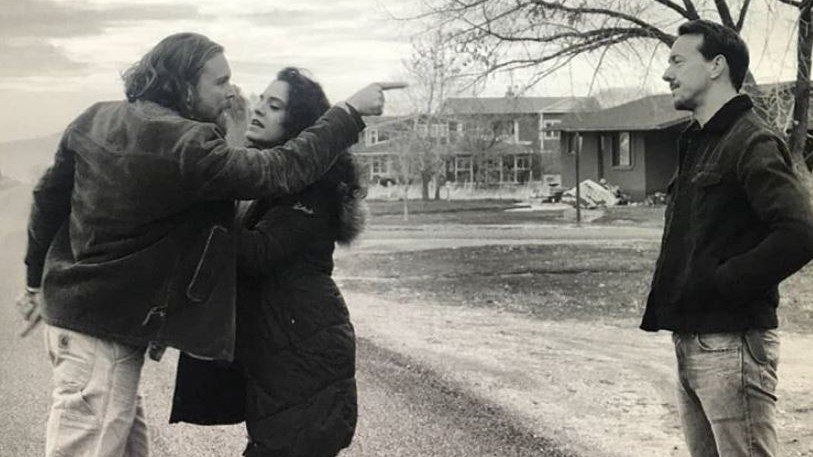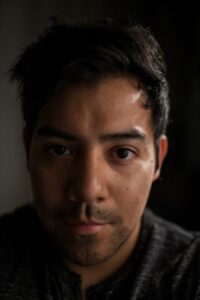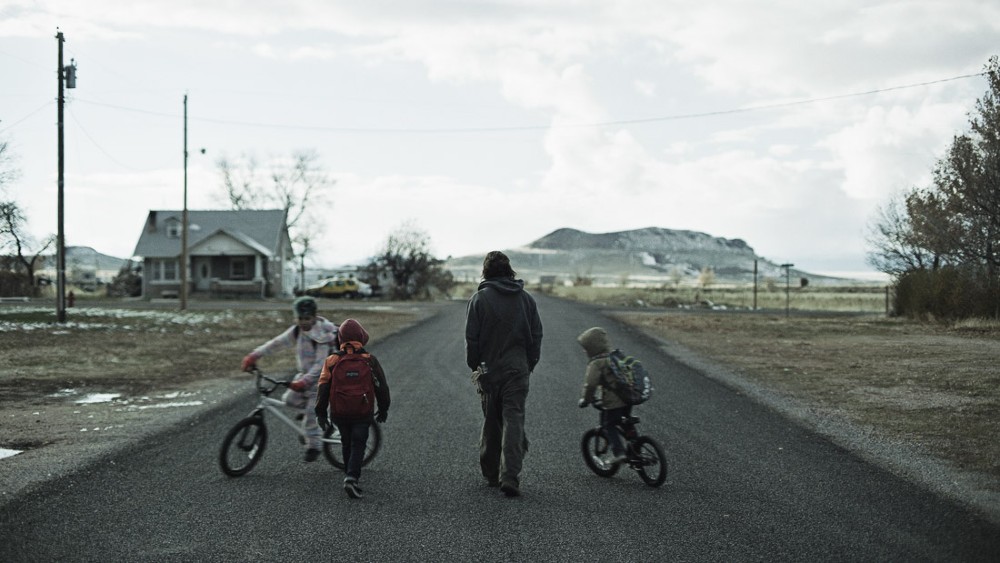
On May 14, Neon released The Killing of Two Lovers, one of the last films from the 2020 Sundance Film Festival to come to audiences. The movie stars Clayne Crawford as David, a desperate father struggling to save his marriage while wielding a gun around, Sepideh Moafi as his estranged wife Nikki, and Chris Coy as Derek, Nikki’s new love interest. The film, by indie filmmaker Robert Machoian, is a tense, even suspenseful drama set in the unforgiving Utah tundra, and features views that are both sweeping but also oddly claustrophobic, as David’s anxiety fills even the open landscape.
Most of the movie takes place in a small town, approximately a ten-block radius, with David ambulating between his father’s house, his pickup truck, and his wife and kids’ home, engaging in stressful conversations mostly right outside these locales. To shoot all of this, Machoian tapped Oscar Ignacio Jimenez as his cinematographer, who like the director himself, attended Brigham Young University.
Below the Line spoke to Ignacio Jimenez last week about what cameras he used, why he decided on an unconventional aspect ratio for most of the filming, and how he achieved such an impressive sense of tightness while filming in vast open spaces. Take a read!

Below The Line: How does it feel to finally get the film all the way from Sundance 2020 to audiences, and tell us how you got involved with this?
Oscar Ignacio Jimenez: Even getting to Sundance was mind-blowing, it’s surreal to be here to be honest. [Director] Rob [Machoian] is a professor in the school I’m going to as an undergraduate in, Brigham Young University. I reached out to him to get technical experience with the camera, and I helped him out in a small project he was working on. About a year later he reached out to me to help him shoot a short. It was called The Miners, and I thought it was for me to be a camera assistant but it turns out he wanted me to be the DP. That film ended up going to Sundance in the shorts category, and I think that was enough for him to trust me—he said he liked my eye and my demeanor, and that was enough for me to have confidence and keep at it.
BTL: Why did you pick a particular aspect ratio, and did you experiment to get there?
Jimenez: The prep time was incredibly short. Robert is an encyclopedia of arthouse film. He assigned me a lot of work on the 1970s cinema. We talked about Wanda by Barbara Loden, and Liverpool by Lissandro Alonso. We noted these were portraits and the more I understood The Killing of Two Lovers the more I saw it as a portrait of a family that was breaking up—two sides of this family, it seemed happy but it was not.
Also, we had a limited budget so we spent some time rehearsing with the 4:3 ratio and shot quickly, before moving on to the next shot. I admired Rob’s discipline to say, “Look we are fine with this shot, it will work.” After one or two days he was letting me compose and light. We did not have to talk—he’d be with the actors and would approve what I did. It was a rewarding experience. I felt like a DP.
What was crazy was that shooting was during finals, and I told him I maybe had to step away for a few hours, but it actually worked out.
BTL: Did you use the 4:3 ratio for inside shoots? Did you ever abandon it?
Jimenez: Yes the ratio was pre-planned for inside, too. There was a bit of a wider shot during the confrontation scene towards the end, to tell the audience this is exploding like a bomb, and give them just a broader perspective for how important the scene was.
BTL: Tell me more about the technology—what cameras did you use, what lenses, etc.?
Jimenez: The camera we used was the Red Helium—we wanted to shoot with an Alexa but the budget did not permit. So the Red was borrowed, and we also borrowed a full set of lenses from Redman Studios in Utah. I only ended up using the 40mm and 50mm we used 99% of the time. There were also the Cooke lenses in there, but we did not use them much at all. They were very pretty, and we only used them for the close-ups, which were few.
BTL: Though the film is set mostly outside, it felt claustrophobic. Was that purposeful?
Jimenez: Absolutely, David’s world is getting compressed inside and outside, with all the stress with his family and Nikki the wife. It’s like a bomb about to go off, as I mentioned. He really has three homes, his dad’s home where he visits, his wife’s home though he never really lives there, and his real home is basically his truck, which of course is very tight for him and feels tight.
BTL: Even though you are outside, you also seem far from the characters—why did you shoot it like this?
Jimenez: The idea is that this is a small town and everyone knows each other. In the first few scenes, like when he goes into the market, the idea is that they all know each other because he greets everyone. We are meant to feel like the neighbors, almost nosey looking into the eyes of others. So we know the situation, but we are watching from a distance like a neighbor. We used a lot of restraint with close-ups to make the intimate moments feel really intimate. Being away is meant to be very voyeuristic.
BTL: What was the hardest part for you working on this film?
Jimenez: I was naïve without knowing what questions to ask. Also the weather was challenging. It could rain, change quickly. Of course, that’s Utah weather and we are used to it, and having a small crew (seven people) made it more flexible. The scariest part of the whole experience was that my gaffer had a health issue two days in and had to leave. I was very proud of what we were able to achieve with such a small crew and my favorite part really was the collaboration, especially with Robert.
I would definitely do it again if he asked.
The Killing of Two Lovers is available to watch in select theaters and On Demand.
All photos courtesy of NEON.







